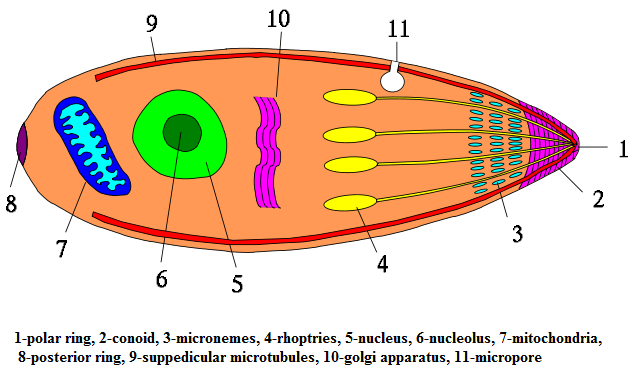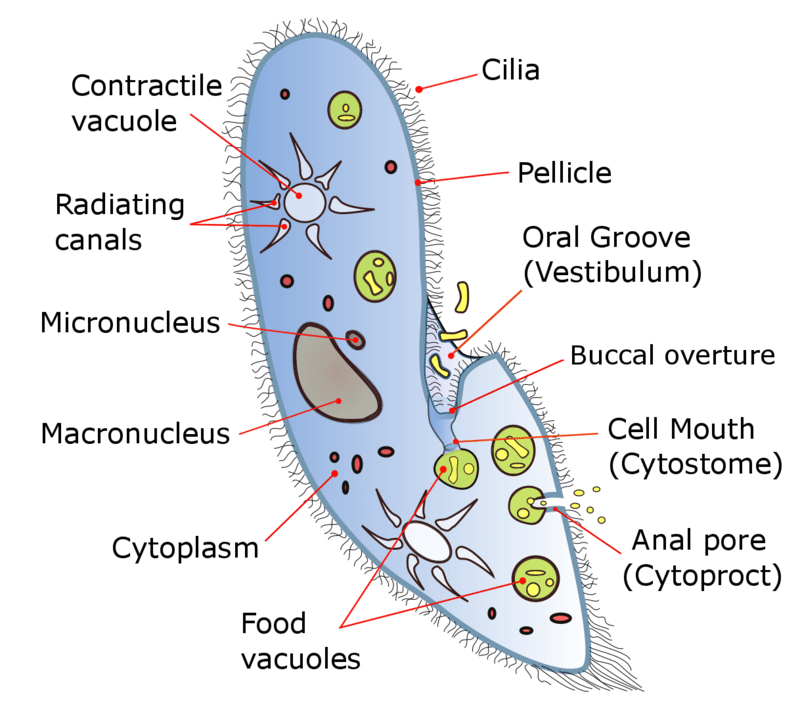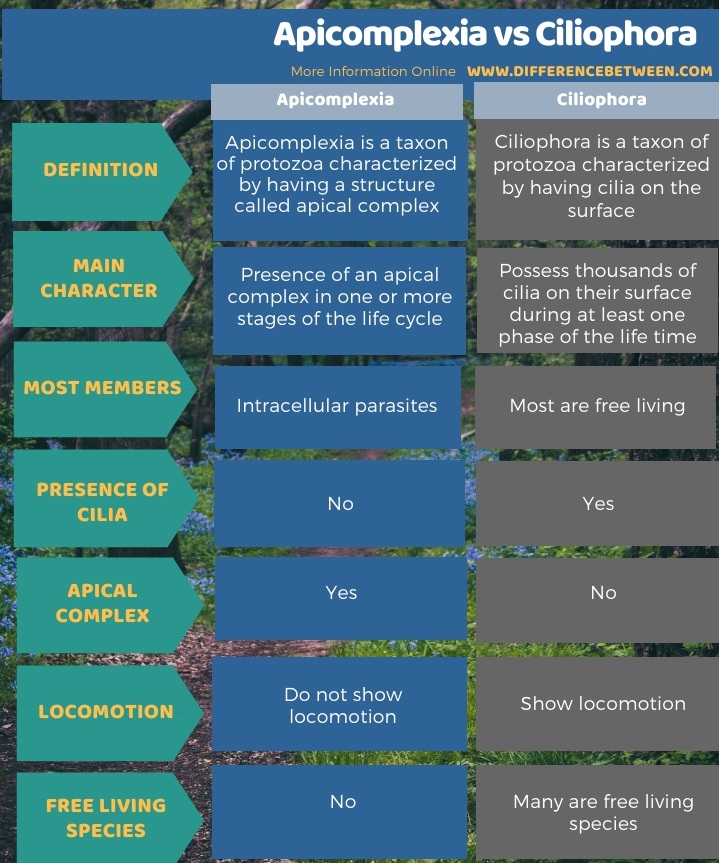The key difference between Apicomplexia and Ciliophora is that Apicomplexia is a subphylum of protozoa and includes organisms with an apical complex, while Ciliophora is another subphylum of protozoa that includes organisms with cilia.
Protozoa is one of the two major groups belonging to the Kingdom Protista. The other group is algae. Protozoans are unicellular animals like eukaryotic organisms. They belong to four classes: Sarcodina (amoebae), Ciliophora (ciliates), Zoomastigophora (flagellates), and Apicomplexa. Apicomplexia possess a structure known as an apical complex, while Ciliophora members have thousands of cilia on the surface of the organism.
CONTENTS
1. Overview and Key Difference
2. What is Apicomplexia
3. What is Ciliophora
4. Similarities Between Apicomplexia and Ciliophora
5. Side by Side Comparison – Apicomplexia vs Ciliophora in Tabular Form
6. Summary
What is Apicomplexia?
Apicomplexia is a group of protozoans that possess apical complexes. Therefore, this group is characterized by having an apical complex in the sporozoite and merozoite stages of all organisms. The apical complex constitutes one or two electron-dense polar rings at the anterior end of the cell, a conoid that lies within the polar ring, and two or more rhoptries located within the polar ring extending posteriorly from the plasma membrane

Figure 01: Apicomplexia Structure
Many members of Apicomplexia are intracellular parasites. Thus, they are pathogenic parasites. They have complex living cycles. In fact, Apicomplexia is the largest and best-known taxon of parasitic protists. They cause serious illnesses. They infect vertebrates as well as invertebrates. For example, Plasmodium is an apicomplexan which causes malaria. Babesia, Cryptosporidium, coccidian, Babesia, Theileria, and Eimeria are several members of apicomplexia. Similar to ciliates, Apicomplexia reproduce by both sexual and asexual methods. But, Apicomplexia does not have cilia or flagella.
What is Ciliophora?
Ciliophora is a subphylum of protozoa. This subphylum consists of ciliated protozoans. They possess thousands of cilia on their surface during at least one phase of the lifetime. Structurally, cilia are short and are present in large numbers compared to flagella. Ciliates anchor the cell using infraciliature. They use cilia for feeding and locomotion. Furthermore, they use cilia for attachment and sensation. Also, they possess two types of nuclei as macronucleus (vegetative nucleus) and micronucleus (generative nucleus).

Figure 02: Ciliate Structure
Most ciliates are free-living, but some are obligate and opportunistic parasitic. They are commonly found in water (in lakes, ponds, oceans, rivers) and everywhere that has water, especially in soil. Ciliates reproduce sexually by conjugation and also asexually by fission. Paramecium, Tetrahymena, and Balantidium Coli are two examples of ciliates.
What are the Similarities Between Apicomplexia and Ciliophora?
- Apicomplexia and Ciliophora are two classes or subphyla of protozoa.
- They are single-celled eukaryotic organisms.
- Moreover, they belong to the kingdom Protista.
What is the Difference Between Apicomplexia and Ciliophora?
Apicomplexia is a group of protozoa that have a structure called apical complex. Meanwhile, Ciliophora is a group of protozoa that have cilia. So, this is the key difference between apicomplexia and Ciliophora. Besides, another difference between apicomplexia and Ciliophora is that apicomplexans are mostly intracellular parasites, while ciliates are mostly free living.
The below infographic shows more comparisons related to the difference between Apicomplexia and Ciliophora.

Summary – Apicomplexia vs. Ciliophora
Apicomplexia and Ciliophora are two major groups of protozoa. Apicomplexia is characterized by having an apical complex, while Ciliophora is characterized by having many cilia on the surface. However, apicomplexia lack cilia and flagella. Therefore, ciliates show locomotion but not apicomplexia. Furthermore, most apicomplexans are intracellular parasites, while most ciliates are free living. So, this is the summary of the difference between Apicomplexia and Ciliophora.
Reference:
1. “Introduction to the Ciliates.” The George Washington University, Available here.
2. “Apicomplexa.” Tulane University, Available here.
Image Courtesy:
1. “Apicomplexa structure” By Franciscosp2 – self-made (with xfig in Linux) (Public Domain) via Commons Wikimedia
2. “Paramecium diagram” By By Deuterostome – Own work (CC BY-SA 4.0) via Commons Wikimedia
ncG1vNJzZmivp6x7pbXFn5yrnZ6YsqOx07CcnqZemLyue8OinZ%2Bdopq7pLGMm5ytr5Wau26tz6KaqKWgobK5tcBmmKecXZi2rbXOqZ%2BoqpFk